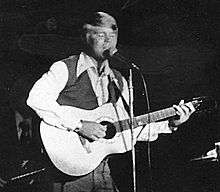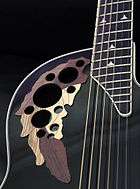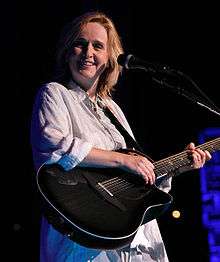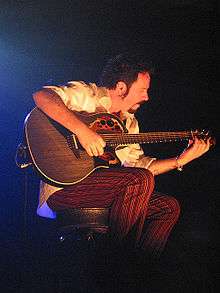Ovation Guitar Company
 | |
| Subsidiary | |
| Industry | Musical instruments |
| Predecessor | Ovation Instruments, a division of Kaman Aircraft[1][2] (c. 1964)[history 1][history 2] |
| Founded | c. 1965, New Hartford, Connecticut |
| Founder | Charles Kaman |
| Headquarters | New Hartford, Connecticut |
| Products | Acoustic guitars |
| Parent | Drum Workshop |
| Website | ovationguitars.com |
The Ovation Guitar Company is a manufacturer of guitars. Ovation primarily manufactures steel-string acoustic guitars (both 6 and 12-string versions) and nylon-string acoustic guitars, often with pickups for electric amplification. In 2015, it became a subsidiary of Drum Workshop after being acquired from KMCMusicorp.[3]
The company's Ovation and Adamas guitars are known for its round back, which gives them a recognizable shape. The latter are also well known for the use of carbon fiber tops (instead of the typically used wood-tops for acoustic guitars). Among musicians the relatively thin neck stands out as well (compared to other acoustic guitars).
History

Founder Charles Kaman (1919–2011) developed the first Ovation guitar in 1965–1966.[4][5][6] Kaman, an amateur guitarist from an early age, worked on helicopter design as an aerodynamacist at United. Eventually, he founded a helicopter design company, Kaman Aircraft, in 1945.[7]
The Kaman Corporation soon diversified, branching into nuclear weapons testing, commercial helicopter flight, development and testing of chemicals, and helicopter bearings production. In the early 1960s, however, financial problems from the failure of their commercial flight division forced them to expand into new markets, such as entertainment and leisure. Charles Kaman, still an avid guitar player, became interested in making guitars.[4][8]
From 1966 to 2007 Ovation guitars, and later on Adamas guitars, were a brand of KMCMusicorp, which itself was a subsidiary of Kaman Aircraft.
In 2008 KMCMusicorp (and with that the Ovation brand) was sold to the Fender Musical Instruments Corporation.[9] In 2014 Fender announced that they are closing the iconic Ovation guitar factory in New Hartford, Connecticut, leaving all production of Ovation guitars overseas.[10] Before that announcement Fender established a U.S. production of various acoustic guitars in the New Hartford factory. Alongside Ovation and Adamas guitars, which have been produced there for decades, Fender started a U.S. production of other Fender-owned brands in that factory, as is known, Guild (Guild Guitar Company) and Fender.[11]
Shortly after closing the New Hartford factory it was announced that the Ovation brand has been sold to the company Drum Workshop, alongside a few other previously Fender-owned brands. The announcement was made on January 7, 2015. Aside from the Ovation brand, Drum workshop has also bought the New Hartford factory and reinstated the previously ceased U.S. production of Ovation and Adamas guitars, basses, ukuleles and mandolins.[12]
Research and development of first models
_fiberglass_round-back%2C_Museum_of_Making_Music.jpg)
Charles Kaman put a team of employees to work to invent a new guitar in 1964.[4][13] For the project, Kaman chose a small team of aerospace engineers and technicians, several of whom were woodworking hobbyists as well. One of these was Charles McDonough, who created the Ovation Adamas model.[history 1] Kaman founded Ovation Instruments, and in 1965 its engineers and luthiers (guitar makers) worked to improve acoustic guitars by changing their conventional materials. The R&D team spent months building and testing prototype instruments. Their first prototype had a conventional "dreadnought" body, with parallel front and back perpendicular to the sides. The innovation was the use of a thinner, synthetic back, because of its foreseen acoustic properties. Unfortunately, the seam joining the sides to the thin back was prone to breakage. To avoid the problem of a structurally unstable seam, the engineers proposed a synthetic back with a parabolic shape. By mid-1966, according to Ovation, they realized that the parabolic shape produced a desirable tone with greater volume than the conventional dreadnought.[14]
Once the engineers had settled on a parabolic shape, they turned their attention to developing a substance that could be molded into this bowl-like shape. Using their knowledge of high-tech aerospace composites, they developed Lyrachord, a patented material comprising interwoven layers of glass filament and bonding resin.
The first successful design, built by luthier Gerry Gardner, went into production soon after the company was established.[15]
The first Ovation guitar made its debut in November, 1966. Its Lyrachord body gave the instrument, according to the company, unprecedented projection and ringing sustain.[history 2] Compared to modern Ovation Guitars the initial instruments had a shiny bowl, that was used again, for example, in the Balladeer 40th anniversary re-issue.
Initial marketing


The introduction and promotion of the first Ovation was closely associated with two performing artists, the blues-performer Josh White and the country-music singer Glen Campbell.
Josh White
In 1965-1967, the Ovation Guitar Company produced a signature guitar for Josh White, which was the first signature guitar made for an African American.[model 1][model 2][model 3][model 4] White was the first official Ovation endorser.[history 3]
Upon completion, the first Ovation Guitar was called the "Josh White Model",[model 5][model 6] which White played at the Hotel America (Hartford, Connecticut), 14 November 1966; at the same show, the Balladeers played Balladeer models.[2] The show was witnessed by "300 representatives of the press and the music industry"[1]
Glen Campbell 1968
The Ovation Roundback Balladeer first caught national attention in 1968 when Glen Campbell was the host of a show called The Glen Campbell Goodtime Hour on CBS, and a year later he became one of Ovation's first endorsers.[4]
Design innovations


Ovation guitar design reflects its founder's engineering training and development of Kaman helicopters. Ovation guitars replace the instrument's conventional back and sides with composite synthetic bowls. Kaman felt there were structural weaknesses in the orthogonal joining of the sides, and that a composite material could provide a smooth body. Ovation claims the parabolic bowls dramatically reduce feedback, allowing greater amplification. Improved synthetics techniques from helicopter engineering control vibrations in the bowl. Ovation developed a thin neck, striving for the feel of an electric guitar's neck, but with additional strength from layers of mahogany and maple reinforced by a steel rod in an aluminum channel.[16] The composite materials and thin necks reduced weight.

For its soundboards, Ovation uses Sitka spruce, a wood that Kaman engineers used in helicopter blades. In the 1970s, Ovation developed thinner soundboards with carbon-based composites laminating a thin layer of birch in its Adamas model. The Adamas model dissipated the sound-hole of the traditional soundboard among 22 small sound holes in the upper chamber of the guitar, which Ovation says yields greater volume and further reduces feedback during amplification (pioneered in the Adamas model in 1977).[16] Although the area of the multiple sound holes is equal to the area of a single-soundhole, the altered position allows a new style of Guitar bracing (e.g. Adamas Bracing). The design strengthens the soundboard, reducing the traditional design's bracing and hence weight. In the 1980s, Ovation introduced shallow-bowl guitars to appeal to electric guitarists.
Later, on-board electronics let guitarists move about the stage rather than stay in front of a microphone. On-board electronic tuning, availability, uniformity, and frugal costs facilitated performances by guitar ensembles like Robert Fripp's Guitar Craft students. Ovation has also produced solid-body electric guitars and active basses.
Ovations reached the height of their popularity in the 1980s, where they were often seen during live performances by touring artists, such as Rush's Alex Lifeson or Paul Simon in the The Concert in Central Park. Ovation guitars' synthetic bowl-shaped back and early use (1971) of pre-amplifiers, onboard equalization and piezo pickups were particularly attractive to live acoustic musicians who constantly battled feedback problems from the high volumes needed in live venues.
Ergonomics
Glen Campbell suggested reducing the weight of the guitar, which caused back strain.[17] Since then, Ovation has reduced the weight of several models and pioneered "super-shallow" guitar bodies.
While it was produced, Ovation's super-shallow 1867 Legend was the recommended guitar in Robert Fripp's Guitar Craft.[18][19] Tamm (1990) wrote that the acoustic 1867 Legend has "a gently rounded super-shallow body design that may be about as close to the shape and depth of an electric guitar as is possible without an intolerable loss of tone quality. Fripp liked the way the Ovation 1867 fitted against his body, which made it possible for him to assume the right-arm picking position he had developed using electric guitars over the years; on deeper-bodied guitars, the Frippian arm position is impossible without uncomfortable contortions".[18]
Model Overview
The Ovation Guitar Company produces guitars under the names Ovation and Adamas.

Ovation guitars have been also produced in China, South Korea and Indonesia. Import models generally have a wooden top. Recently, Ovation significantly reduced U.S production. From 2010 on, better models—Legend, Elite, Custom Legend, Custom Elite—were made both in the U.S. and in Korea. Before that, these models were U.S. made. In recent years, many U.S. made are identifiable by "LX" in the product name (e.g., Legend 2077LX), whereas Korean versions have "AX" in the model name (e.g., Legend 2077AX). Ovation does not use this convention on all models (e.g., Ovation 1617ALE). Currently, Ovation produces only a few U.S. made models, mostly signature and limited edition models (e.g., Custom Legend 1769-ADII Al DiMeola). Production of the standard model range of Ovation guitars in the U.S. has been ceased under the ownership of Fender Musical Instruments Corporation, but is about to be reinstated by the new owner Drum Workshop.[12] [20]

The Adamas name mainly stands for guitars with a carbon fiber top, although there are exceptions (one is the Adamas 2081WT - WT stands for woodtop). Until the closure of the New Hartford, Connecticut factory in June 2014, all Adamas models were produced in the U.S.[21]
LX does not only stand for U.S. made. Originally LX indicated an Ovation guitar that included new features not available on previous models.
Back in 2007 Ovation explained on its website that new features included the new OP-Preamp, an advanced neck system (lightweight dual-action truss rod, carbon fiber stabilizers), a patented pickup (made of 6 elements), inlaid epaulets, scalloped bracing, and a new hard composite Lyrachord GS body.[model 8] Back then, there was no AX model line. The first AX models appeared on the Ovation-website in 2010. Based on the website's history, the LX features were introduced in 2004.
Upper-level guitars: Balladeer, Legend and Elite
There are mainly two lines:
- Legend and Standard Balladeer models have one large sound hole as on most acoustic guitars (Standard Balladeer, Legend, Custom Legend - produced in Korea).
- Elites have several smaller sound holes (Standard Elite, Elite, Custom Elite - produced in Korea).
The first Ovation guitar model was a Balladeer (later known as Standard Balladeer)[model 9]
-

Balladeer
-
.jpg)
Clasica Roger Waters model.
-
.jpg)
Patriot
-

Ultra (c.1995)
-

Collector's Series 2007-BCS[model 1]
Cite error: There are <ref group=model> tags on this page, but the references will not show without a {{reflist|group=model}} template (see the help page).
Entry-level guitars: Applause and Celebrity
Ovation has two lines of entry-level guitars. Applause, the lowest cost line, with mainly laminated tops, is imported from China. Celebrity models are imported from China or Korea, and range from entry-to-medium level laminated top models, to high-end, solid top models with lots of ornamentation.
-
.jpg)
Applause AE-38
-

Celebrity LCC047
-

Applause
-

Celebrity CC44
-
.jpg)
Celebrity Deluxe CC257
Electric guitars: Semi-hollow and solid bodies
In 1967–1968, Ovation introduced and produced its Electric Storm Series of archtop guitars and basses with semi-hollow bodies. The pickups for these instruments were manufactured by Rowe Industries, who produced DeArmond music products in Toledo, Ohio. Production stopped in 1969.[22]
In 1972, Ovation introduced one of the first production solid-body electric-guitars with active electronics, the Ovation Breadwinner. The model did not become popular, however, and production of the Breadwinner and the Ovation Deacon ceased in 1980. Ovation made several other solid-body models up until the mid 1980s.[model 10] Since that time, the company has focused mainly on acoustic and acoustic-electric guitars.
-
.jpg)
K-1260 Tornado (1967/1968), a thinline hollow body electric guitar[1]
-

Breadwinner (1970s)
-

Deacon (1973–1982)
-

K-1271 Viper (c.1977)[model 1]
-

K-1261 Magnum 1 bass (c.1978)[model 2]
-

K-1264 Magnum 4 bass (c.1978)[model 3]
- ^ "Electric Storm Hollowbodies". 40 years of innovation - Ovation Timeline, OvationGuitars.com. Kaman Music Corp. 2007. Archived from the original on 2007-08-18.
Cite error: There are <ref group=model> tags on this page, but the references will not show without a {{reflist|group=model}} template (see the help page).
Other instruments: acoustic bass guitars, ukuleles, mandolins
Ovation also offers bass guitars, ukuleles, and mandolins.
-

Ovation electro-acoustic bass guitar
-
Ovation electro-acoustic ukulele
-

Ovation electro-acoustic mandolin
Performers using or endorsing Ovations

Ovation guitars have been used and endorsed by many professional musicians, including:
- Glen Campbell; DJ Ashba, Melissa Etheridge, Nikki Sixx, Mick Thomson; Kaki King, Steve Lukather; Marcel Dadi, Ray Davies,[23] Tom T Hall, Country Bill Huey Nova Scotia Country Music Hall Of Fame member, Roy Harper,[24] James Hetfield, Josh Homme, Cyndi Lauper, Alex Lifeson, John Lennon, Chad Morgan, Country Joe McDonald, David Gates, Roger Miller, Roger Voudouris, Jimmy Griffin, Janis Ian
- John McLaughlin, Yngwie Malmsteen, Bob Marley, Ziggy Marley, Bob Welch, Stephen Marley, Lindsey Buckingham, Roman Miroshnichenko, Maury Muehleisen, Dave Mustaine, Vince Neil, Jimmy Page, Richard Daniel Roman, Harry Chapin, Alexander Rosenbaum, Shania Twain, Boz Scaggs, Luis Alberto Spinetta, Statler Brothers, Cat Stevens, Red Symons, Mike Rutherford, Steve Hackett, Van Morrison and Aaron Tippin;[23]
- Bob Weir, Joan Armatrading, Roy Clark, Jim Croce, Kevin Cronin, Neil Diamond, Al Di Meola, Robert Fripp, Mick Jagger, Greg Lake, Adrian Legg, Paul McCartney, Brian May, Bjorn Ulvaeus, Benny Andersson, Freddie Mercury, Kenny Loggins, Jim Messina, Steve Morse, Eddie Rabbitt, Kenny Rogers, Richie Sambora, Tom Scholz, Seal, Bob Seger, Paul Simon, Rick Springfield, Russell Javors, Alun Davies, Jeff Lynne, David Brown, Steve Miller, Phil Judd, Don Spencer, Terry Kath, Peter Cetera, Eddie Van Halen, Sean Derek Wilson, and Nancy Wilson;[25]
- Dan Peek, Dewey Bunnell, Gerry Beckley, Roy Orbison, Kelly Groucutt, Davey Johnstone
- Roger Waters and David Gilmour.[26][27]
- Kevin Cronin
-

Heart's Nancy Wilson (pictured) plays an Adamas model.
-
Melissa Etheridge's Ovation exhibited at Hard Rock Cafe Florence.
See also
References
- 1 2 "Helicopter Pioneer To Make Guitars - Kaman Aircraft Corp. unveil radical Ovation line of acoustical guitars" (PDF). The Music Trades. December 1966.
- 1 2 1966_Ovation_Original_Program (PDF). demonstration dinner show program (Ovation Instruments). 14 November 1966.
- ↑ "KMC Music Sells Percussion Brands, Ovation Guitars to Drum Workshop". Music Inc. Magazine. January 6, 2015.
Fender Musical Instruments Corporation (FMIC) announced today that its subsidiary, KMC Music, has sold its owned and licensed percussion brands, including Gretsch Drums, Latin Percussion, Toca Percussion, KAT Percussion and Gibraltar Hardware — as well as the Ovation guitar brand and the exclusive U.S. distribution rights for Sabian Cymbals — to Drum Workshop, Inc., the manufacturer of DW drums, hardware and accessories.
- 1 2 3 4 Cruice (1996)
- ↑ Carter (1996, pp. 24–36)
- ↑ Press release "Statement from Kaman Corporation, On the Death of Company Founder, Charles Huron Kaman". Kaman Corporation. January 31, 2011. Retrieved February 1, 2011.
- ↑ Carter (1996, pp. 12–16)
- ↑ Carter (1996, pp. 17–18)
- ↑ Press release "Fender Buys Kaman". American Songwriter. October 29, 2007. Retrieved August 22, 2015.
- ↑ The factory was reopened in October, 2015 by current owner Drum Workshop, Inc. Press release "Sounds Of Silence: Ovation Guitar Closing New Hartford Factory". Hartford Courant. April 23, 2014. Retrieved August 22, 2015.
- ↑ Press release "Factory Tour: Fender Acoustic Custom Shop • Guild Guitars • Ovation". premierguitar.com. June 18, 2013. Retrieved August 22, 2015.
- 1 2 Press release "Ovation to restart U.S. production". Jazzmando.com. July 22, 2015. Retrieved August 22, 2015.
- ↑ Carter (1996, Chapter 2 "A better guitar", p. 23)
- ↑ Carter (1996, Chapter 2 "A better guitar": "The roundback", p. 24)
- ↑ "Time Off". timeoff.com.au.
- 1 2 Denyer (1989), p. 48
- ↑ Carter (1996, Chapter 3 "Into production": "Glen Campbell", p. 46)
- 1 2 Tamm (1990, Chapter 10 "Guitar Craft")
- ↑ "English rocker Robert Fripp with a favorite instrument of his, a super-shallow bowl Legend" is the caption for a picture of Fripp in Carter (1996, Chapter 7 "Bill Kaman and the KMC [Kaman Music Corporation]": "Changes", p. 93)
- ↑ "Ovation im Wandel". Ovation Reference Shop (in German). Musikhaus Andresen GmbH. 2012-09-20. Archived from the original on 2013-03-18. Retrieved 2012-09-20.
- ↑ Dowling, Brian (2014-04-23). "Sounds Of Silence: Ovation Guitar Closing New Hartford Factory". The Hartford Courant. Retrieved 2014-04-30.
- ↑ Carter (1996, Chapter 4 Electrification: A brief Electric Storm, p. 58)
- 1 2 "Artists". OvationGuitars.com. Archived from the original on 2014-01-12.
- ↑ "Ovation [Roy Harpers use of Ovation Guitars]". Music UK (Guitar Special 1985): 84–85. 1985.
- ↑ Carter (1996, p. 127 (index), apart from Seal with bass guitar on p.100)
- ↑ Fitch (2005, pp. 416–430, 441–445): Fitch, Vernon (2005). The Pink Floyd Encyclopedia (Third ed.). London: Collector's Guide Publishing, Inc. ISBN 978-1-894959-24-7.
- ↑ Fitch, Vernon; Mahon, Richard (2006). Comfortably Numb. A history of The Wall. Pink Floyd 1978–1981. PFA Publishing, Incorporated. p. 268. ISBN 978-0-9777366-0-7.
- comprehensive history
- 1 2 "Charlie Kaman's Story". OvationGuitars.com. Archived from the original on 2014-01-08.
- 1 2 "The History of Ovation Guitars". OvationGuitars.com. Archived from the original on 2014-01-08.
- ↑ "The History of Ovation Guitars". Muncie, Indiana: World Music Supply. Archived from the original on 2013-12-18.
- model
- ↑ "Ovation Josh White Model Brochure". Ovation Instruments. 1967/1968. Check date values in:
|date=(help) - ↑ "History Detectives - Josh White Guitar". Oregon Public Broadcasting / Public Broadcasting Service (PBS).
- ↑ "History Detectives - Josh White Guitar" (transcription). Oregon Public Broadcasting / Public Broadcasting Service (PBS).
- ↑ "Ovation Josh White". OvationGallery.com.
— Josh White was Ovations very first endorsee - ↑ "1965 Ovation Josh White - OM Acoustic Guitar". Dream Guitars.
- ↑ "Shiny Bowl Series 1966-1969". OFC Members Serial Number List, OvationGallery.com.
— Ovation early serial numbers, Josh White and Balladeer models - ↑ "Custom Legend 1769 ADII Al Di Meola: The ultimate Ovation". OvationGuitars.com. Archived from the original on 2014-01-08. Retrieved 8 February 2012.
- ↑ "Ovation Features - The LX Upgrade". OvationGuitars.com. 2007-10-30. Archived from the original on 2007-10-30. Retrieved 2012-09-20.
- ↑ "Ovation Balladeer". OvationGallery.com. 2008. Retrieved 2012-09-25.
- ↑ Carter (1996, Chapter 4 "Electrification": "Ovation solidbodies", pp. 59–64, and "Toward solidbody success", p. 65)
Bibliography
- Anonymous, Music Trades (1 October 2004). "Ovation's encore: How a host of product refinements have rekindled growth at Kaman Music's flagship guitar division". The Music Trades. The Guitar Market. (subscription required). Retrieved 1 May 2012.
- Carter, Walter (1996). Eiche, Jon, ed. The history of the Ovation guitar. Musical Instruments Series (first ed.). Milwaukee, Wisconsin: Hal Leonard Corporation. pp. 1–128. HL00330187, ISBN 978-0-7935-5876-6, ISBN 0-7935-5876-X (softcover), ISBN 0-7935-5948-0 (hardcover).
- Cruice, Valerie (8 December 1996). "From the ratcheting of helicopters to a guitar's hum". The New York Times.
- Denyer, Ralph (1992). "Ovation guitars (Acoustic guitars)". The guitar handbook. Special contributors Isaac Guillory and Alastair M. Crawford;>Robert Fripp (foreword) (Fully revised and updated ed.). London and Sydney: Pan Books. p. 48. ISBN 0-330-32750-X.
- Marks, Brenda (30–31 May 1999). "Connecticut firm makes guitars, helicopter blades from same fiberglass". Waterbury Republican-American (New Hartford, Conn.: Knight Ridder/Tribune Business News). (subscription required). Retrieved 24 April 2012.
- Tamm, Eric (1990). "Ten Guitar Craft". Robert Fripp: From Crimson King to crafty master (Progressive Ears ed.). Faber & Faber (1990).
External links
| Wikimedia Commons has media related to Ovation. |
- Official website Ovation
- Official website DW Drums